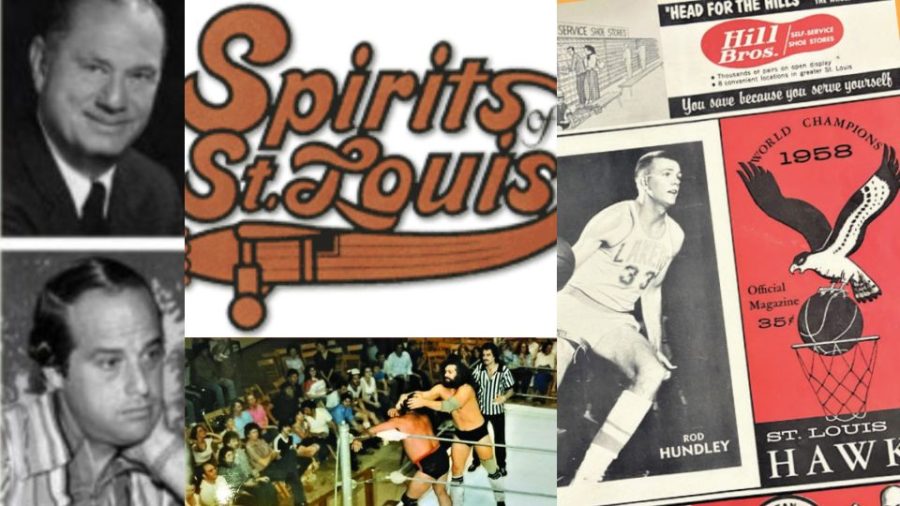The four Jewish families of St. Louis sports left longlasting legacies to this day
Published December 15, 2022
It’s no secret that St. Louis is and has always been a great sports city. For more than a century the Gateway City has been a hotbed of professional and amateur sports with a diverse history and an evolving legacy of success.
In “St. Louis Sports Memories: Forgotten Teams and Moments from America’s Best Sports Town,” local author Ed Wheatley relives the highlights from the championships to the crossroads of social change that have characterized St. Louis’ sports scene. And weaved within this colossal tale is a unique Jewish story, one that deserves to have more light shined on it.
In preparation for his upcoming book signings this weekend, the Jewish Light talked with Wheatley to examine in greater detail, what we’re calling the “The Four Jewish Families of St. Louis Sports.” So first a little background information about these families and then onto the Q&A.
The Four Jewish Families
Through their sports, the Saloman Family (professional hockey), Sam Muchnick (professional wrestling) and the Silna and Kerner families (professional basketball), brought St. Louis into national and international focus.
For nearly three decades, until Muchnick’s retirement in 1983, St. Louis was the world capital of professional wrestling – its guidance came via his leadership of the NWA (National Wrestling Association) and the St. Louis Wrestling Club. It just wasn’t the iconic television show “Wrestling at the Chase,” it was the day to day matches coordinated across all the nation’s wrestling territories as well as other countries. Muchnick is a member of the St. Louis Jewish Sports Hall of Fame.
On Feb. 9, 1966, St. Louis was awarded a National Hockey League (NHL) franchise for an expansion team that didn’t even have an owner lined up. That void was soon filled by the late Sidney Salomon Jr. and his son Sid Salomon III, who came forward to purchase the franchise and its original venue, the art deco St. Louis Arena on Oakland Avenue. In October 1967, the team started its first season. Salomon Jr. is a member of the St. Louis Jewish Sports Hall of Fame.
The 1950s saw the rise of the National Basketball Association (NBA) and St. Louis, thanks to Ben Kerner, was at the forefront with the St. Louis Hawks 13 season (1955-1968) tenure. It was a successful run that saw the team in the NBA Finals 4 times while winning it all in the 1957 season. Gifted with many great stars and Hall of Famers, there was only one year during their time here that they did not make the playoffs. Kerner is a member of the St. Louis Jewish Sports Hall of Fame.
After Kerner took his team to Atlanta, the Silnas tried to restore basketball in St. Louis in 1974 with the rival America Basketball Association’s (ABA), St. Louis Spirits. During their two-year run, the Spirits were not a very good team, despite having some very good players.
JL: What would you say is Sam Munchnick’s legacy in what he did here in St. Louis?
EW: The best way to summarize Sam’s impact on St. Louis is simply, “oh the memories.” In a time when wrestling television revenues were higher than baseball, basketball, and football combined, wrestling was an entertainment source at a time unlike today when there were very few other forms of entertainment.
For many it became a Saturday night tradition of popcorn and soda pop when families gathered in the “front room” around their sole television and watched and believed the mayhem on the screen or kids being forced to get up and go to early church on Sunday mornings so the family could be back home to watch the re-airing on Sunday mornings.
Some say it is the memory of hearing their mother cuss for the first time with her reaction to a certain something in the ring or to see their grandmother plop down on all fours and count out the fallen wrestler with the referee. Everyone in St. Louis has a very special memory of Wrestling a the Chase and with it a very big smile as they tell you their story.
JL: What would you say the family’s legacy is for what they did in St. Louis. Does their impact still resonate in today’s sports landscape?
EW: If it had not been for the Salomons, there would not have been a hockey team in St. Louis in 1967. The deal was in the works to put the NHL expansion team in Baltimore, but the Wirtz family that owned the Blackhawks as well as the St. Louis Arena put things in motion to get a team in St. Louis and purchase the Arena. Salomon was the man to get it done and he did and he was also the man who would win over the fans and the players and set the stage for 50+ years of St. Louisans “bleeding blue.”
He lavishly refurbished the bones of the Arena and besides the Blues, brought St. Louis University hockey to town. He was the man that created and made the city’s love affair with St. Louis Blues hockey.
JL: Can you explain who Ben Kerner was and his complete impact on St. Louis Sports history?
EW: He is the man who brought NBA basketball to St. Louis and did so with much success. His teams fielded some of the early NBA greats and would regularly go deep into the playoffs. Like all teams of that era, they would all but one time be stopped by the great Boston Celtic teams.
There is a backstory with the Hawks about how they actually had the rights to future NBA superstar Bill Russell but let him go to the Boston Celtics as the foundation of their dynasty. What would have happened if Russell had played alongside the Hawks superstar Bob Petit? Would basketball have stayed and remained popular?
Even after taking the Hawks to Atlanta, Kerner made St. Louis his home, living in Creve Coeur just off Ladue road on the west side of I-270 and remained very active in the St. Louis sports scene.
JL: Explain who these brothers were, and how they got the ABA to come to St. Louis?
EW: They were basketball fans who got in on the expansion of a rival league to the NBA. They signed some very big name players and put out a good product but St. Louisans were drawn to both Cardinals teams and the Blues. There was also an underlying current in which St. Louisans were not ready to see an all-African American team playing a sport. That feeling had an impact on the Hawks as well and contributed to their relocation. In the end, just as the Hawks attendance figures declined, the Spirits were not winning at the turnstiles – drawing roughly 1,000 fans in the 18,000-seat Arena.
JL: Explain what many call the “the deal of the century?”
EW: The NBA sought a solution to the rapidly failing ABA and once and for all eliminate it as a competitor through a quasi-merger. Four ABA teams would join the NBA and the others would get essentially a lump sum buyout. The Silna’s held out and negotiated a 2% television revenue agreement for perpetuity. It would give them more money than they ever would get at the turnstiles. After netting over $250M, the NBA reached an agreement with the Silnas to buy out their agreement in 2014 for another $500M – a pretty good investment on a team that played only two years.
This weekend Wheatley will be here signing copies of “Forgotten Moments and Memories from America’s Best Sports Town” as well as copies of his other titles – Wrestling at the Chase, Baseball in St. Louis, and his kid’s title, Incredible Cardinals.
On Saturday, December 17, he’ll be at Barnes & Noble in Chesterfield from 11 a.m. to 1 p.m.
On Sunday, December 18, he’ll be at Christopher’s in Kirkwood from 12 p.m. to 2 p.m.
















